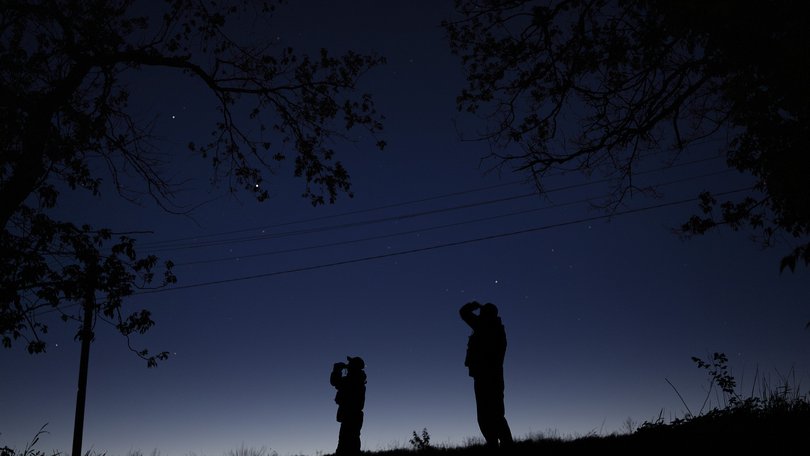THE NEW YORK TIMES: As drone warfare evolves, the Pentagon sees its own vulnerabilities

The Pentagon has been working to beef up drone defences at overseas bases in the past 18 months, after three Army reservists were killed in an attack by an Iran-backed militia on an outpost in Jordan early last year.
But in recent months, the US military has seen a potentially broader vulnerability, as both Israel and Ukraine attacked adversaries with drones smuggled deep behind enemy lines.
The audacious and creative use of drones by an Israeli intelligence agency to mount strikes from inside Iran, and Ukraine’s so-called Operation Spider’s Web, which knocked out Russian strategic bombers with drones launched from inside Russia, has made clear that the threat to the US military is not just overseas, but also at home.
Sign up to The Nightly's newsletters.
Get the first look at the digital newspaper, curated daily stories and breaking headlines delivered to your inbox.
By continuing you agree to our Terms and Privacy Policy.American defence companies are pushing new technologies that they say can more effectively intercept drones. The companies are hoping that the billions of dollars the Pentagon is planning to invest in missile defence — the so-called Golden Dome program — will also be used to build up new drone defences.

Some new technologies aim not to shoot down drones one by one, but use what is known as directed energy, including high-powered microwaves, to take down large swarms of drones at once. The military has conducted at least two tests of the new microwave system, including one in the Middle East and one in the Pacific, setting the stage for a bigger Pentagon investment.
The leaders of Epirus, the company that developed the microwave defence, have warned that the rise of new kinds drones means the US military faces a “guerrilla war of machines,” a style of fighting that is alien to the Pentagon’s traditional way of thinking.
Andy Lowery, chief executive of Epirus, said drone warfare between Russia and Ukraine had evolved with breathtaking speed.
“What we saw in Russia will play out here,” he said. “Operation Spider’s Web should be a real wake-up call to us, to the whole world, that this is very, very serious.”
Ukraine, with US help, has invested in drone technology and has developed new kinds of drones that can be used against ships, planes and tanks. American officials estimate that in recent months, Ukrainian drones have caused some 70% of Russian casualties.
During Operation Spider’s Web, Ukraine’s intelligence agency smuggled drones across Russia to strike multiple air bases at once, destroying a large number of Russian strategic bombers. The attack highlighted how effective relatively cheap, concealable drones can be against traditional militaries.
“We’re watching with our jaws dropped down on how fast the Ukrainians adapt to new technologies,” Lowery said.
Russia has used its own drones and ones built by Iran to terrorize Ukrainian troops and the country’s civilian population. Iranian drones have been used by Tehran-backed militias, not just in the attack in Jordan that killed the US Army reservists, but in Syria, Iraq and Yemen.
And Israel’s use of drones smuggled into Iran in its initial attack on the country’s nuclear program last month showed how quickly new technologies were spreading around the world.
Shifting its strategy to counter drones, experts said, has challenged the Pentagon.
“This is a Sept. 11-style problem, and we are still operating in a Sept. 10 mindset,” said Christian Brose, chief strategy officer at Anduril, a defence company that makes equipment for the U.S. military to detect and destroy adversarial drones. “On the day after a catastrophic attack, there is going to be a string of evidence that we should have seen this coming.”
Pentagon officials insist they are taking the threat seriously and making investments to improve defences.
American commanders, especially in the Middle East, have taken steps over the past several years to build what the military calls a layered network of defences, including jamming devices, missiles and other systems, to ward off hostile drone, rocket and missile attacks.
Those efforts accelerated after the three Army reservists were killed in January 2024 at a remote logistics outpost in northeast Jordan called Tower 22. The drones were fired at the base by Iran-backed militias.
Since then, the military has made “considerable improvements across the board,” Adm Charles B Cooper II, President Donald Trump’s nominee to be the next head of the Pentagon’s Central Command, told senators last month.
“We really are leaps and bounds ahead of where we were before” the attack in Jordan, Mr Cooper said. “Having said that, I would never be satisfied that we have the maximum readiness.”
But Mr Brose and others said the threat is not just at overseas bases. In December 2023, surveillance drones flew over an Air Force base in Virginia where F-22 planes were stationed.
“Does anyone believe if a country wanted to try to do to us what the Ukrainians did to Russia that they wouldn’t have a decent ability to be successful?” Mr Brose asked. “Do we think it’s impossible that a willing adversary couldn’t sneak nefarious drones into the country?”
Lowery, the Epirus chief executive, noted that the Pentagon had spared counter-drone defences from its across-the-board cuts announced earlier this year.
In hearings on Capitol Hill last month, Defence Secretary Pete Hegseth was asked repeatedly by Republican and Democratic lawmakers about America’s vulnerability to drone attacks.
Mr Hegseth said that “cheaper, one-way commercially available drones with small explosives represent a new threat.”
Mr Hegseth said that he met with Gen. Dan Caine, the chair of the Joint Chiefs of Staff, and top aides soon after the Ukrainian attacks to ensure that military forces based in the United States and overseas were adequately protected.
The secretary recently approved the creation of a new organisation, led by the Army, to address drone warfare and counter-drone measures, Gen James Mingus, the Army’s vice chief of staff, said at a conference in Washington last week.
The organization is modeled after an agency the Pentagon formed two decades ago to counter roadside bombs that insurgents used against US troops in Iraq and Afghanistan.
The Army oversees drone defence for the military. But critics of the Army’s past approaches have said its counter-drone defences are built on older technology and are not adaptable enough, given how quickly the drone threat has evolved on the battlefield in Ukraine.
New technologies can detect and identify incoming drones, then take them out more efficiently. Older technology, critics say, is poor at identifying drones, including which ones pose the most acute and immediate threat. Robust drone defence requires multiple ways to take out a drone, some defence experts said.
Anduril, which has contracts with Special Operations Command and the Marine Corps, has a counter-drone system that combines methods for detecting a drone, including cameras and radar, with various ways to take it down, including shooting down the drone and jamming it.
Supporters of those technologies say the innovations show that the government does not have to invent counter-drone systems, but simply adopt new technologies more quickly. Corporations making new anti-drone technologies have complained that government regulations hinder development.
Lowery compared the emerging drone threat to a famous scene from Star Wars.
“We aren’t thinking about the fact that an X-Wing pilot dropped a little bomb in the middle of the Death Star and blew the whole thing to smithereens,” Lowery said.
This article originally appeared in The New York Times.
© 2025 The New York Times Company
Originally published on The New York Times
